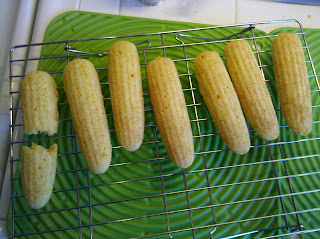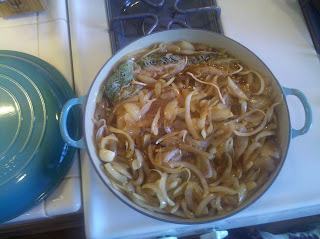My Mom used to make cinnamon swirl bread sometimes when I was a kid. The other day I decided I had to have some! I've worked with yeast breads before (with some success), but it has been many years. I had just been to Costco and bought some fresh yeast and my other ingredients were fresh, so off I went.
 |
| America's Test Kitchen Family Baking Book |
I only needed the yolks from my eggs, so I put the whites into a container (and marked it!) for the freezer - most likely destined to be a future Angel Food Cake.
King Arthur Flour has this cool yeast spoon that measures out exactly the amount of yeast in one of those little packets - 2.25 tsp.
Here's my ingredients all measured out...wasn't sure which way to go with it, so I did it both ways.
You mix the brown and white sugars and reserve some for the topping. I made a little error here - I should also have mixed in the cinnamon at this point but I didn't figure that out until later. I still used the cinnamon in the swirl part, but just lightly spread it around over the sugars. It turned out fine, but I'll pay more attention next time.
I gently warmed up the milk, and whisked in the melted butter and the egg yolks here.
I put most of the flour and yeast salt and (cinnamon) sugar mixture in the mixer.
Then I slowly added the milk mixture into the dry with the mixer on low...this took about 2 minutes.
At this point I thought it needed a bit more of the flour, so I put in just a spoonful at a time till it came together.
Then I turned it out on a floured board...
...and smoothed it out into a ball.
I lightly oiled this bowl and put the dough in here to rise. Then I also lightly oiled some cling film and put that on top.
Earlier I had turned my oven on low for a few minutes and then turned it off. Here is where I put the dough to rise.
And here she is about an hour and a half later. POUFY.
Then I turned it out on the board. I wish I had a little bit bigger board but oh, well. I tried to spread it out like they said, but the dough was a little rebellious and would only work with me so far.
Here is where I sprinkled the sugar mixture on and wondered, "What about the cinnamon?"...so I read more carefully and realized it should have been in there all along. So I just dusted it on there and then rolled it up, pinched it closed, and put it in the lightly oiled pan seam side down.
Here's how she is after the second rise.
On goes a little more of the cinnamon sugar and a spritzing of water to keep it in place.
And here is the finished bread! I liked how much this rose, but maybe next time I will use a slightly larger pan. See the little gap in the bottom there? Oops...gotta watch how I place it in the pan, too.
I think this 'tearing' effect is from the top not being nice and smooth going into the oven. It didn't affect the taste at all.
And here are the lovely swirls! If I had been able to spread the dough out more, I would've gotten a more swirly effect than this one, but I'll take this for a first effort. :-)
The only real problem this bread presented was the AWESOME yummy smell driving everybody crazy in the house until we could dig into it!
That little gap there came from not rolling the dough quite snugly enough in that spot.
Next time I will try it with raisins.
This experience has renewed an interest in bread-baking for me so I have been reading the bread books in my collection and hope to be doing more soon. I always thought you were sorta locked into a time thing when working with breads - how long it has to rise, etc. But as I'm reading, you can exercise a measure of control over the process - speeding up or slowing down the rising process. I'm so excited about this, because maybe it means I won't have to always wait for a weekend day to try a new bread!
~ks


























































